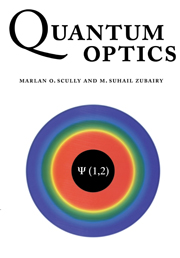Book contents
- Frontmatter
- Contents
- Dedication
- Preface
- 1 Quantum theory of radiation
- 2 Coherent and squeezed states of the radiation field
- 3 Quantum distribution theory and partially coherent radiation
- 4 Field–field and photon–photon interferometry
- 5 Atom–field interaction – semiclassical theory
- 6 Atom–field interaction – quantum theory
- 7 Lasing without inversion and other effects of atomic coherence and interference
- 8 Quantum theory of damping – density operator and wave function approach
- 9 Quantum theory of damping – Heisenberg–Langevin approach
- 10 Resonance fluorescence
- 11 Quantum theory of the laser – density operator approach
- 12 Quantum theory of the laser – Heisenberg–Langevin approach
- 13 Theory of the micromaser
- 14 Correlated emission laser: concept, theory, and analysis
- 15 Phase sensitivity in quantum optical systems: applications
- 16 Squeezing via nonlinear optical processes
- 17 Atom optics
- 18 The EPR paradox, hidden variables, and Bell's theorem
- 19 Quantum nondemolition measurements
- 20 Quantum optical tests of complementarity
- 21 Two-photon interferometry, the quantum measurement problem, and more
- Index
7 - Lasing without inversion and other effects of atomic coherence and interference
Published online by Cambridge University Press: 05 June 2012
- Frontmatter
- Contents
- Dedication
- Preface
- 1 Quantum theory of radiation
- 2 Coherent and squeezed states of the radiation field
- 3 Quantum distribution theory and partially coherent radiation
- 4 Field–field and photon–photon interferometry
- 5 Atom–field interaction – semiclassical theory
- 6 Atom–field interaction – quantum theory
- 7 Lasing without inversion and other effects of atomic coherence and interference
- 8 Quantum theory of damping – density operator and wave function approach
- 9 Quantum theory of damping – Heisenberg–Langevin approach
- 10 Resonance fluorescence
- 11 Quantum theory of the laser – density operator approach
- 12 Quantum theory of the laser – Heisenberg–Langevin approach
- 13 Theory of the micromaser
- 14 Correlated emission laser: concept, theory, and analysis
- 15 Phase sensitivity in quantum optical systems: applications
- 16 Squeezing via nonlinear optical processes
- 17 Atom optics
- 18 The EPR paradox, hidden variables, and Bell's theorem
- 19 Quantum nondemolition measurements
- 20 Quantum optical tests of complementarity
- 21 Two-photon interferometry, the quantum measurement problem, and more
- Index
Summary
Quantum coherence and correlations in atomic and radiation physics have led to many interesting and unexpected consequences. For example, an atomic ensemble prepared in a coherent superposition of states yields the Hanle effect, quantum beats, photon echo, self-induced transparency, and coherent Raman beats. In fact, in Section 1.4, we saw that the quantum beat effect provides one of the most compelling reasons for quantizing the radiation field.
A further interesting consequence of preparing an atomic system in a coherent superposition of states is that, under certain conditions, it is possible for atomic coherence to cancel absorption. Such atomic states are called trapping states†. The observation of nonabsorbing resonances via atomic coherence and interference impacts on the concepts of lasing without inversion (LWI),‡ enhancement of the index of refraction accompanied by vanishing absorption, and electromagnetically induced transparency.
In lasing without inversion, the essential idea is the absorption cancellation by atomic coherence and interference. This phenomenon is also the essence of electromagnetically induced transparency. Usually this is accomplished in three-level atomic systems in which there are two coherent routes for absorption that can destructively interfere, thus leading to the cancellation of absorption. A small population in the excited state can thus lead to net gain. A related phenomenon is that of resonantly enhanced refractive index without absorption in an ensemble of phase-coherent atoms (phaseonium). In a phaseonium gas with no population in the excited level, the absorption cancellation always coincides with vanishing refractivity.
- Type
- Chapter
- Information
- Quantum Optics , pp. 220 - 247Publisher: Cambridge University PressPrint publication year: 1997
- 7
- Cited by



